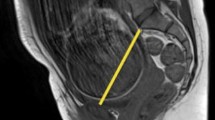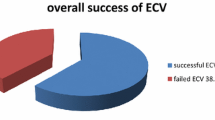Abstract
Purpose
To evaluate the obstetrical prognosis of term breech delivery in case of asymmetric pelvis.
Methods
An observational, comparative, retrospective, bi-centric study of 559 patients who had a computer tomography pelvimetry prior to delivery of a term breech presentation was conducted between August 2013 and August 2019. Patients with an attempted vaginal delivery were divided into two groups: a group of asymmetric pelvis (AP) when the difference between the lengths of both oblique diameters was ≥ 1 cm and a group of symmetric pelvis (SP) when the two oblique diameters differed by < 1 cm. The primary outcome was the rate of vaginal delivery. Secondary outcomes were a composite variable of neonatal and maternal morbidity and mortality.
Results
Of the 370 patients who attempted a vaginal breech delivery, 8% (n = 29) had an AP and 92% (n = 341) had a SP. In the AP group, the vaginal delivery rate was higher (93% versus 78%, p = 0.05). There was no statistically significant difference in neonatal (3% versus 1% in the AP and SP groups, respectively, p = 0.4) and maternal (17% versus 23% in the AP and SP groups, respectively, p = 0.5) morbidity and mortality.
Conclusion
When a pelvimetry is performed before an attempt of vaginal breech delivery, a difference of less than two centimetres between both oblique diameters does not seem to reduce the rate of vaginal birth and is not an indication for an elective caesarean section.



Similar content being viewed by others
References
Hickok DE, Gordon DC, Milberg JA, Williams MA, Daling JR (1992) The frequency of breech presentation by gestational age at birth: a large population-based study. Am J Obstet Gynecol 166:851–852
Lansac J, Crenn-Hebert C, Rivière O, Vendittelli F (2015) How singleton breech babies at term are born in France: a survey of data from the AUDIPOG network. Eur J Obstet Gynecol Reprod Biol 188:79–82
Hannah ME, Hannah WJ, Hewson SA, Hodnett ED, Saigal S, Willan AR (2000) Planned caesarean section versus planned vaginal birth for breech presentation at term a randomised multicentre trial. Term breech trial collaborative group. Lancet Lond Engl 356:1375–1383
Hansen AK, Wisborg K, Uldbjerg N, Henriksen TB (2008) Risk of respiratory morbidity in term infants delivered by elective caesarean section: cohort study. BMJ 336:85–87
Van den Berg A, Van Elburg RM, Van Geijn HP, Fetter WP (2001) Neonatal respiratory morbidity following elective caesarean section in term infants. A 5 year retrospective study and a review of the literature. Eur J Obstet Gynecol Reprod Biol 98(1):9–13
Truffert P (2000) Neonatal consequences of caesarean section. J Gynecol Obstet Biol Reprod (Paris) 29:17–21
Carayol M, Alexander S, Goffinet F (2004) Mode of delivery and term breech presentation in the PREMODA cohort. J Gynecol Obstet Biol Reprod Paris 33:37–44
Goffinet F, Carayol M, Foidart J-M, Alexander S, Uzan S, Subtil D et al (2006) Is planned vaginal delivery for breech presentation at term still an option? Results of an observational prospective survey in France and Belgium. Am J Obstet Gynecol 194:1002–1011
Carbonne B, Goffinet F, Bréart G, Frydman R, Maria B, Uzan S et al (2001) The debate on breach presentation: delivery of breach presentations: the position of the National College of French gynaecologists (CNGOF). J Gynecol Obstet Biol Reprod (Paris) 30:191–192
Azria É (2020) Breech Presentation: CNGOF guidelines for clinical practice-case selection for trial of labour. Gynecol Obstet Fertil Senol 48:120–131. https://doi.org/10.1016/j.gofs.2019.10.026
Schaal JP, Riethmuller D (2012) Pelvic bony dystocia. Mechanics and obstetrical techniques. Sauramps Médical, Montpellier, pp 433–484
Buthiau D (2003) Computerized tomography pelvimetry: recent advances. Gynecol Obstet Fertil 31:465–470
Third- and Fourth-degree Perineal Tears, Management (Green-top Guideline No. 29). R Coll Obstet Amp Gynaecol n.d. https://www.rcog.org.uk/en/guidelines-research-services/guidelines/gtg29/. Accessed 16 Apr 2020
Ruf H, Blanc B, Conte M, Adrai J, Delpont P, Dupont S (1985) Clinical and radiological assessment of pelvic bony dystocia. Editions techniques. Encycl Méd Chir,s Paris, France
Rozenberg P (2007) Is there a role for X-ray pelvimetry in the twenty-first century? Gynecol Obstet Fertil 35:6–12
Kotaska A, Menticoglou S, Gagnon R, Farine D, Basso M, Bos H et al (2009) SOGC clinical practice guideline: vaginal delivery of breech presentation. Int J Gynaecol Obstet Off Organ Int Fed Gynaecol Obstet 107:169–176
Deutsche Gesellschaft für Gynäkologie und Geburtshilfe (DGGG) (2010). Arbeitsgemeinschaft Maternofoetale Medizin und Board für Pränatal- und Geburtsmedizin. Geburt bei Beckenendlage [AWMF-Leitlinien-Register Nr. 015/051 Entwicklungsstufe: 1]; letzte Überarbeitung
Toivonen E, Palomäki O, Huhtala H, Uotila J (2012) Selective vaginal breech delivery at term-still an option. Acta Obstet Gynecol Scand 91:1177–1183
Ben Abdennebi A, Aubry S, Ounalli L, Fayache MS, Delabrousse E, Petegnief Y (2017) Comparative dose levels between CT-scanner and slot-scanning device (EOS system) in pregnant women pelvimetry. Phys Med 33:77–86. https://doi.org/10.1016/j.ejmp.2016.12.008
Sigmann M-H, Delabrousse E, Riethmuller D, Runge M, Peyron C, Aubry S (2014) An evaluation of the EOS X-ray imaging system in pelvimetry. Diagn Interv Imaging 95:833–838
Gabriel R, Harika G, Bonneau S (2016) Obstetrical pelvis. Anatomy clinical and radiologic study. EMC Elsevier Masson SAS, pp 5–007
Nicholson C, Allen HS (1946) Variation in the female pelvis. Lancet 248:192–195
Michel SCA, Rake A, Treiber K, Seifert B, Chaoui R, Huch R et al (2002) MR obstetric pelvimetry: effect of birthing position on pelvic bony dimensions. AJR Am J Roentgenol 179:1063–1067
Keller TM, Rake A, Michel SCA, Seifert B, Efe G, Treiber K et al (2003) Obstetric MR pelvimetry: reference values and evaluation of inter and intra-observer error and intra-individual variability. Radiology 227:37–43
Michel S, Drain A, Closset E, Deruelle P, Subtil D (2009) Evaluation of decisional elements of vaginal delivery in case of breech presentation in 19 university hospitals in France. J Gynécol Obstét Biol Reprod 38:411–420
Van Loon AJ, Mantingh A, Serlier EK, Kroon G, Mooyaart EL, Huisjes HJ (1997) Randomised controlled trial of magnetic-resonance pelvimetry in breech presentation at term. Lancet Lond Engl 350:1799–1804
Balleyguier C, Jouanic JM, Corréas JM, Benachi A, Dumez Y, Menu Y (2003) CT pelvimetry: a new approach using multi detector CT and volume rendering. J Radiol 84:425–427
Lenhard MS, Johnson TRC, Weckbach S, Nikolaou K, Friese K, Hasbargen U (2010) Pelvimetry revisited: analyzing cephalopelvic disproportion. Eur J Radiol 74:e107–e111
Huerta-Enochian GS, Katz VL, Fox LK, Hamlin JA, Kollath JP (2006) Magnetic resonance-based serial pelvimetry: do maternal pelvic dimensions change during pregnancy? Am J Obstet Gynecol 194(6):1689–1694
Offringa Y, Mottet N, Parant O, Riethmuller D, Vidal F, Guerby P (2019) Spatulas for entrapment of the after-coming head during vaginal breech delivery. Arch Gynecol Obstet 299:1283–1288
Author information
Authors and Affiliations
Contributions
ML: protocol/project development, data collection or management, data analysis, manuscript writing/editing. TC: data collection or management, manuscript writing/editing. YO: data collection or management, manuscript writing/editing. SA: data collection or management. AB: manuscript writing/editing. DR: manuscript writing/editing. RR: manuscript writing/editing. PG: manuscript writing/editing. NM: protocol/project development, manuscript writing/editing.
Corresponding author
Ethics declarations
Conflict of interest
The author declares that they have no conflict of interest.
Ethical approval
All procedures performed in studies involving human participants were in accordance with the ethical standards of the institutional and/or national research committee and with the 1964 Helsinki declaration and its later amendments or comparable ethical standards. This study has been approved by the Institutional Review Board of the French College of Obstetricians and Gynaecologists (CEROG No. 2019-OBS-0302).
Informed consent
Informed consent was obtained from all individual participants included in the study.
Additional information
Publisher's Note
Springer Nature remains neutral with regard to jurisdictional claims in published maps and institutional affiliations.
Rights and permissions
About this article
Cite this article
Lallemant, M., Ceri, T., Offringa, Y. et al. Asymmetric pelvis and term breech presentation: is planned vaginal delivery still a safe option?. Arch Gynecol Obstet 304, 919–927 (2021). https://doi.org/10.1007/s00404-021-06036-4
Received:
Accepted:
Published:
Issue Date:
DOI: https://doi.org/10.1007/s00404-021-06036-4




